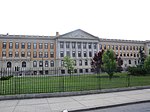Long Dock Tunnel
CSX Transportation tunnelsErie Railroad tunnelsNorfolk Southern Railway tunnelsRailroad tunnels in New JerseyTransportation in Jersey City, New Jersey ... and 2 more
Tunnels completed in 1860Tunnels in Hudson County, New Jersey

The Long Dock Tunnel is a freight rail tunnel in Jersey City, New Jersey that is part of the North Jersey Shared Assets Area and used by CSX Transportation on the National Docks Secondary. The single track (formerly dual track) tunnel runs through Bergen Hill, a section of the lower New Jersey Palisades in Hudson County.
Excerpt from the Wikipedia article Long Dock Tunnel (License: CC BY-SA 3.0, Authors, Images).Long Dock Tunnel
NJ 139 Upper Level, Jersey City
Geographical coordinates (GPS) Address Nearby Places Show on map
Geographical coordinates (GPS)
| Latitude | Longitude |
|---|---|
| N 40.7355 ° | E -74.0574 ° |
Address
NJ 139 Upper Level
NJ 139 Upper Level
07306 Jersey City
New Jersey, United States
Open on Google Maps










